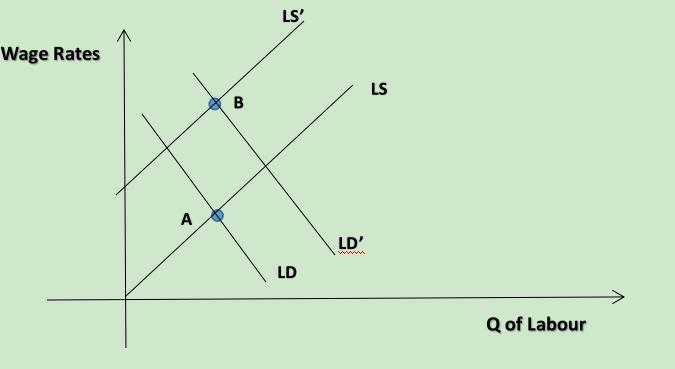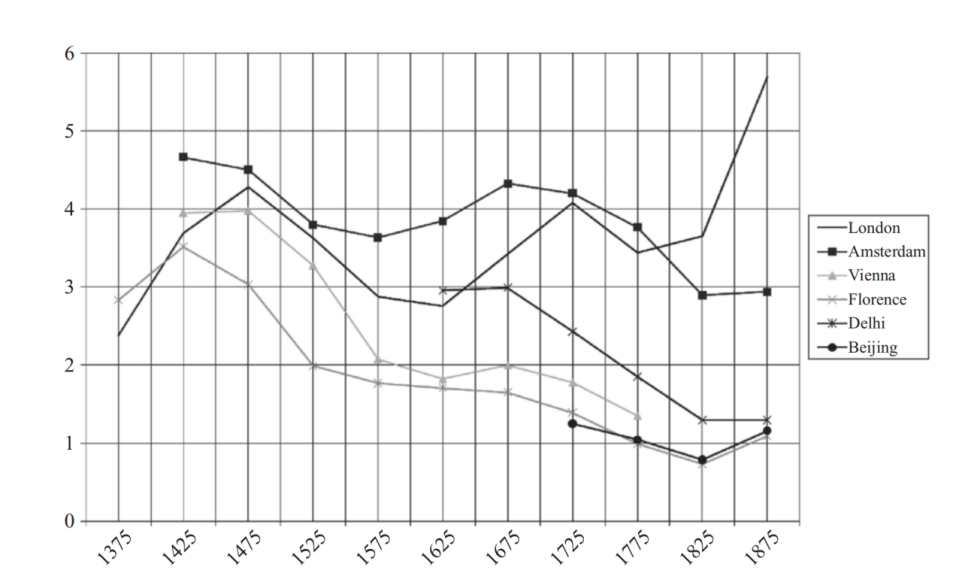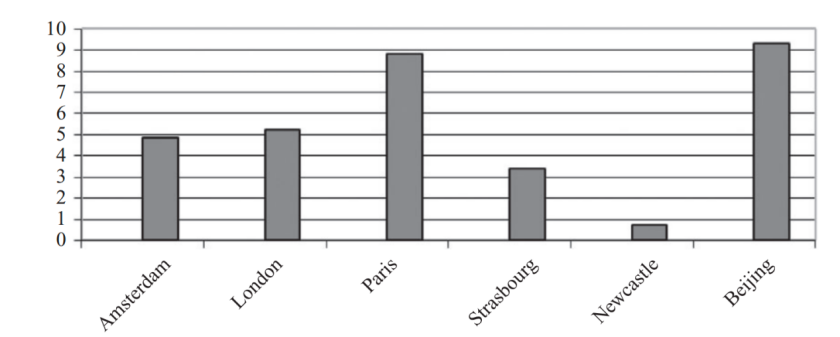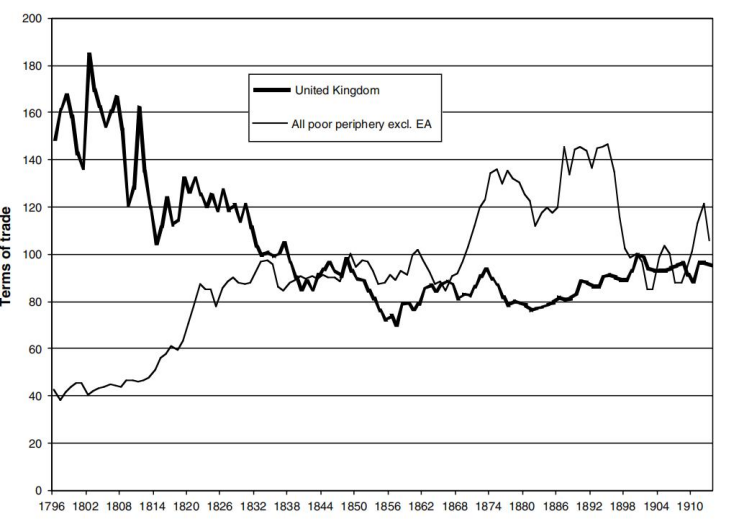1. Introduction
Since the industrial revolution, firstly emerged in UK during sixteen century, the western nations and the rest of the world gradually became divergent in technology and GDP (for some scholars, this phenomenon is defined as “the Great Divergence”). Wallerstein [1], according to the economic features, the world is classified into the core, semi-periphery, and periphery. The core western nations, through the industrial revolution, developed labour-intensive industries. The outcome of the industrialization should spread globally. However, the industrialization process was laggard in the peripheries and some nations even experienced an unexpected de-industrialization process, specialized on primary industries like cotton and other labour-intensive fields [2]. In Arthur’s work, he attributed this phenomenon to both political and economic factors and heeded the booming factoral terms of trade, which is a potential account for the de-industrialization process in the peripheries. Williamson [3], on the basis of Arthur’s work, further examined the terms of trade and the volatility of international economy in the “long ninetieth century” (from 1782 to 1916) and found these two factors may contribute to the de-industrialization in the peripheries. This paper aims to elaborate on the impact of terms of trade to de-industrialization. In the first section, a historical review of the industrial revolution is provided from the British industrial revolution to the early 20th century. This paper will elaborate on why Britain was the first nation to industrialize and provide an explanation why the peripheries did not industrialize from the point of education, politics, and economics, and the focus will shift to the abnormal terms of trade and how they affected the de-industrialization process of the third-world nations. In the second section of the paper, it will provide the econometric examination to show that the negative relationship between the TOT and de-industrialization.
2. Industrialization in the UK
One forehead question is that why is it UK who firstly began the industrial process instead of other Western European or other peripheral nations? One possible account is UK’s special domestic factor market structure which contributes to the industrial process. During the 17th century, UK had experienced pandemics, booming international trade through special geographic characteristics, both of which, combined, made UK a high-wage, cheap energy economy at this period [4]. The unusual high wage rate is caused by the medieval black death, which decreases the labour supply in Britain and pull the wage rates (LS to LS’ in Figure 1). Also, the booming international trade began in 16th century, when the UK started to transport the woollen cloths to the European main continent from London, which further increases the labour demand in Britain (LD to LD’ in Figure 1). Two factors combined, the overall wages of British workers is thus increased (Point A to B in Figure 1). Furthermore, Figure 2 compares labor wage rates in major cities around the world, demonstrating that from the beginning of the nineteenth century, the labor wage was higher than in other cities. The British economy is also advantaged for its cheap energy price. As shown in the Figure 3, the energy price is relatively low among the main cities. The reason of this phenomenon is straightforward: the coal resources in the UK is abundant.

Figure 1: the Mechanism of high-wage rates in Britain.

Figure 2: Wage rates Comparison between main cities.

Figure 3: Nature resources comparison.
The high-wage, cheap-energy economy of Britain made domestic firms changed their investment strategies: a firm often minimize the cost of at and maximize profit at
\( \frac{MPL}{W}=\frac{MPC}{P} \)
in which MPC represents marginal products per capital, MPL represents marginal products per labour, P represents the price of capital, and W represents wage rates. Before the UK starts industrial revolution, the wage rate remains relatively high among main cities around the world, and the resources price is somehow relatively cheap. Thus, firms, to minimize the costs, tended to make more investments in the manufacturing industries like the coals instead of the primary industries.
The science revolution from Enlightenment during 17th to 18th century may also contribute to UK’s industrial process by providing sufficient technology supply. For the UK, their knowledge base of industrialization is prompted by “savants” like Newton and Bacon. Also, with the advancement of transportation revolution, the access cost of knowledge, especially the transmitting is heavily reduced [5]. These two factors, together, make knowledge required for industrialization easier to be conveyed to people and the technology supply is increased. The supply and demand for technology in pre-industrialized Britain are significantly advanced, resulting in a flurry of inventions in the 1970s, such as the steam engine and the spinning Jenny. Thus, the industrialization process starts much earlier in the UK than in other nations.
3. De-industrialization in the Peripheries
Abnormally, the outcome of Britain industrial process only facilitate the industrial process in western capitalism Europe but not the rest of the world like the east Europe, Asia, and Africa. With the industrialization of western nations, the peripheries have two options: to imitate or to trade with industrialized nations. For nations in the west Europe and north America like France and the US, follow the path of industrialization immediately. However, most countries, even Central European nations, did not react positively to the industrialization process and the world was thus divided into industrial and non-industrial nations. Obviously, nations’ divergent reactions can be attributed to both intellectual and politic issues.
With the spreading of industrialization and natural science, nations can easily acquire the necessary knowledge for industrialization and can voluntarily begin the industrial process. During the 19th century, Japan and China tried to voluntarily catch up with Western advanced technologies. In China, the Qing dynasty initiated the Westernization Movement in 1862 to learn advanced technologies and knowledge by establishing western-style new schools, translating foreign literature, and sending domestic students to Europe and America. Westernization Movement is overall “partially successful”: the military forces were significantly advanced and the overall domestic education level was prompted. For Japan, like the Qing dynasty, the Meiji government started the restoration in the education field since 1871: reforming domestic education system by setting up school districts, building western-type imperial universities, and sending international students oversea [6]. As discussed before, one vital factor that contributes to the UK’s industrial process is the booming technology supply driven by Enlightenment. For both China and Japan, the educational reforms are nuanced in an approximate period, which provide sufficient technology supply. However, the paths after these two movements are divergent: for Japan, it triumphantly complete the industrial process and oriented to capitalism, but for China, the industrial process was still laggard. The divergent outcome of China and Japan may provide a rebuttal to the intellectual issues. As a matter of fact, for nations who wish voluntarily start the industrial process, they can always gain the required knowledge easily, but except the western Europe, most nations did not start the industrialization. Therefore, intelligence may not be the determining factor of the industrial process.
Political impediment of the colonialism may also affect the industrial process in the peripheries. The 19th century is a period with colonialism and the monarchical states are often willing to the industrial process of the colonies. During the nineteenth century, India, as a British colony, imposed a heavy tax on the cotton and steel industries. Despite the domestic cheap labor force and both British and international demand for cotton, the Indian cotton industry developed to a large extent under a heavy tax burden [7], and the iron and steel industrial process was initially hampered However, Brazil in the 19th century experienced a great growth in the coffee industry. Unlike the tense political environment of India, Brazil had a relatively loose political control from the imperialism. Still, Brazil did not start the industrial process during the 19th century as a peripheral nation. Though under the circumstance of India, the intense political hindrance indeed damage the domestic industrial process, some peripheries, like Brazil, even without political restrictions, did not begin industrialization. Thus, political restriction alone cannot explain the laggard industrial process in the peripheries.
Both intellectual and political factors can not solely explain the lagging industrial process in the periphery. Moreover, the peripheries did not just start the industrial process, but some nations were experiencing the de-industrialization and a new explanation is needed. The analysis is naturally shitted to economic factors. One possible account for this de-industrialization process in the peripheries could be the abnormal booming terms of trade during the “long 19th century”(from 1782 to 1916). Normally TOT(terms of trade) is defined as
\( {TOT_{t}}=\frac{{Pex_{t}}}{{Pim_{t}}} \) (1)
where Pex is defined as the overall price of exporting goods, Pim stands for overall the import goods price and t is the time factor, in which stands for each year in the context of this paper. Normally, if TOT of a nation is continuously increasing (TOTt > TOTt-1), the export will be advantaged since through exporting, the nation can gain more benefit and vice versa. Figure 1.2 shows a continuously decreasing TOT in the UK and a increasing TOT in the poor peripheries since 1796. Thus, for the peripheries, there is an incentive to export goods and these goods are often primary labour-intensive goods.

Figure 4: The downward and booming terms of trade in the UK and peripheries.
Table 1: Trends of terms of trade in the core and peripheries.
Region | Starting year in the series | Peak year | Annual growth rate between half-decades start to peak(%) | Annual growth rate between half-decades start to 1886-90(%) |
All periphery excl. EA | 1796 | 1860 | 1.431 | 0.726 |
European peripheries | 1782 | 1855 | 2.434 | 1.234 |
Latin America | 1782 | 1895 | 0.873 | 0.851 |
Middle East | 1796 | 1857 | 1.683 | 0.872 |
South Asia | 1782 | 1861 | 0.904 | 0.037 |
Southeast Asia | 1782 | 1896 | 1.423 | 1.423 |
East Asia | 1782 | None | NA | -2.119 |
European peripheries | 1782 | 1855 | 2.434 | 1.234 |
Italy | 1817 | 1855 | 3.619 | 0.697 |
Russia | 1782 | 1855 | 2.475 | 1.335 |
Spain | 1782 | 1879 | 1.505 | 1.264 |
Latin America | 1782 | 1895 | 0.873 | 0.851 |
Argentina | 1811 | 1909 | 1.165 | 1.284 |
Brazil | 1826 | 1894 | 1.115 | 1.067 |
Chile | 1810 | 1906 | 0.966 | 0,140 |
Cuba | 1826 | None | NA | -1.803 |
Mexico | 1782 | 1878 | 1.096 | 0.989 |
Venezuela | 1830 | 1895 | 0.692 | 0.677 |
Middle East | 1796 | 1857 | 1.683 | 0.872 |
Egypt | 1796 | 1865 | 2.721 | 1.571 |
Ottoman Turkey | 1800 | 1857 | 2.548 | 1.233 |
South Asia | 1800 | 1861 | 0.904 | 0.037 |
Ceylon | 1782 | 1874 | 0.670 | 0.366 |
India | 1800 | 1861 | 0.932 | 0.024 |
Southeast Asia | 1782 | 1896 | 1.423 | 1.423 |
Indonesia | 1825 | 1896 | 3.294 | 3.335 |
Philippines | 1782 | 1857 | 1.480 | 0.720 |
Siam | 1800 | 1857 | 1.534 | 0.397 |
East Asia | 1782 | None | NA | -2.119 |
China | 1782 | None | NA | -2.342 |
Nations are more specialized due to the unceasingly increasing terms of trade, which further cause the de-industrial process in the third world. This phenomenon could be explained by Ricardo’s comparative advantage theory. For the industrialized nations like the the UK and France, owing to the high productivity, they will gain comparative advantages in industrial and capital-intensive goods. By comparison, the peripheral nations gain the comparative advantages in primary and labour-intensive commodities. According to Ricardo’s theory, it will be more beneficial for the third-world nations to be specialized in the primary goods like cotton and textile. As discussed in the industrial process in the UK, the technology supply is increased by capital-intensive industries. Likewise, the labour demand is increased in the peripheries, which provide the incentives for the third world to be more specialized in the primary labour-intensive industries. For the third world, the cost to develop capital-intensive industries is more expensive than labour-intensive industries and the benefit may not be obvious. Thus, peripheral nations have no incentives to start the industrial process, and even voluntarily decrease the manufacturing industries. As shown in Table 2, the periphery, particularly India and China, has experienced an extreme decline in global manufacturing share since 1750, while the developed core has experienced an increase in manufacturing share [8][9].
Table 2: The trend of ML in the core and periphery.
1750 | 1800 | 1830 | 1860 | 1880 | 1900 | 1913 | |
Developed countries | 27.0 | 32.3 | 39.5 | 63.4 | 79.1 | 89.0 | 92.5 |
Europe | 23.2 | 28.1 | 34.2 | 53.2 | 61.3 | 62.0 | 56.6 |
Outside Europe | 3.9 | 4.2 | 5.3 | 10.2 | 17.8 | 26.9 | 35.9 |
Third World | 73.0 | 67.7 | 60.5 | 36.6 | 20.9 | 11.0 | 7.5 |
China | 32.8 | 33.3 | 29.8 | 19.7 | 12.5 | 6.2 | 3.6 |
India-Pakistan | 24.5 | 19.7 | 17.6 | 8.6 | 2.8 | 1.7 | 1.4 |
World | 100 | 100 | 100 | 100 | 100 | 100 | 100 |
World:absolute value | 127.3 | 146.9 | 184.4 | 225.9 | 320.1 | 540.8 | 932.5 |
4. The Econometric Approach
The historical study and explanation of de-industrialization is now comprehensive and the mechanism between the booming TOT and de-industrialization is clear. However, the econometric approach is needed to examine the exact relation between the TOT and the de-industrialization. One possible indicator to estimate the the de-industrial process is the manufacturing share of the peripheries (MS), since as the ongoing of the industrialization in the developed nations and de-industrialization in the peripheral nations, the manufacturing share of the third-world nations should decrease. However, this indicator may not be precise enough: with the ongoing industrialization process, the manufacturing level of both core and peripheral nations could increase. Another possible indicator is the global manufacturing level of the peripheries (ML), which is a more precise indicator to reflect the realistic degree of manufacturing. The ML is calculated by world absolute value multiplied with the share of the periphery from table 2. Thus, the econometric model is
\( {ML_{t}}={β_{0}}{TOT_{t}}+{β_{1}}+{μ_{t}} \) (2)
where MS stands for the manufacturing share of nations, TOT represents the terms of trade in different nations, and index t is the time factor, standing for different years.
Table 3: The OLS between ML and TOT.
ML | Coefficient | Standard Error | t Statistics | P-value | {95%confidence.interval} | |
TOT | -.346993 | .2560303 | -1.36 | 0.233 | -1.005146 | .3111475 |
_cons | 112.2775 | 22.43006 | 5.01 | 0.004 | 54.61921 | 169.9358 |
Number of observations =7
F(1,5) =1.84
Probability>F =0.2333
squared = 0.2687
Adjusted R-squared = 0.1224
Root MSE = 17.804
The OLS estimation has confirmed again the negative relation between manufacturing level (ML) and terms of trade (TOT). Also, as shown in the table 3 the t statistics (-1.36) and P value (0.233) indicate the slope is an appropriate estimation and should be accepted.
However, this OSL estimation may have potential drawbacks. On the one hand, the data of manufacturing level is from table 2, which only provide the data 7 years of the long period. Thus, the chronological data of a widener period is needed to confirm the estimation. On the other hand, the error term \( {μ_{t}} \) may not be independent from terms of trade (TOT) and manufacturing level (ML). In fact, Williamson [3] has provided the view that the volatility of TOT may contribute to de-industrialization process. Also, Baxter and Kouparitsas [10] studied that the goods price cause the variation in terms of trade. A better econometric model could conclude the volatility of TOT, which is the first derivative of TOT versus time. Thus, the complete equation could be a differential equation. Also, Baxter and Kouparitsas [10] studied that the goods price cause the variation in terms of trade. Further works may lie in this perspective.
\( {ML_{t}}={β_{0}}{TOT_{t}}+{β_{1}}\frac{∂TOT}{∂t} +{β_{2}}+{μ_{t}} \) (3)
5. Conclusion
To sum up, during the long 19th century, core nations like the UK and the peripheries showed divergent paths. In pre-industrialized Britain, British firms are encouraged to make more investments in manufacturing industries due to the unusually high wage of labours and low capital prices. Technology-driven industries in Britain thus advance in a high speed. Moreover, the knowledge basis of industrialization is assured by the Enlightenment and technology supply thus increase. These two factors, combined, made Britain began the industrial revolution earlier than any other nations. For the peripheries, the education and politic impediments may contribute to the laggard process of industrialization. However, nations with education flaws acted differently like China and Japan. Also, though it is proven that the colonial politic impediment prevent some nations from industrialization, some nations without such impediment failed to industrialize as well. Thus, a more general explanation is needed, and the view lies on the economic explanation. Economically, through the process of international division of labour, the industrial process in the developed countries may cause the de-industrial process in the third world. After the industrial process of core nations, for the peripheries, comparative advantages were gained in labour-intensive industries and they specialized in these industries instead of capital-intensive industries, leading to the de-industrialization during 19th century. This is again proved by the OSL analysis with 7 periods. However, this model has potential drawbacks, since the sample size is not large enough and fails to derive the independent error terms.
References
[1]. Wallerstein, Immanuel (1974). The Modern World-System I: Capitalist Agriculture and the Origins of the European World-Economy in the Sixteenth Century. New York: Academic Press.
[2]. Lewis, W. Arthur (1978). The Revolution of the International Economic Order. Princeton University Press.
[3]. Williamson, J. G.(2008). Globalization and the Great Divergence: terms of trade booms, volatility and the poor periphery, 1782–1913. European Review of Economic History, 12(3), 355-391.
[4]. Allen, R.C. (2011). “Why the Industrial Revolution Was British: Commerce, Induced Invention, and the Scientific Revolution.” The Economic History Review 64, no. 2: 357–84.
[5]. Mokyr, J. (2005). The Intellectual Origins of Modern Economic Growth. The Journal of Economic History 65, no. 2: 285–351.
[6]. Beasley, W. G (1972). the Meiji Restoration. Stanford, Calif : Stanford University Press.
[7]. Alka Raman (2022). Indian cotton textiles and British industrialization: Evidence of comparative learning in the British cotton industry in the eighteenth and nineteenth centuries. the Economic History Review. 75:447–474. doi:10.1111/ehr.13143.
[8]. Williamson, Jeffrey G (2011).Trade and Poverty: When the Third World Fell Behind. Cambridge: MIT Press.
[9]. Bairoch, P(1982).International Industrialization Levels from 1750 to 1980.Journal of European Economic History; Rome Vol. 11, Iss. 2, (Fall 1982): 269.
[10]. Kouparitsas, Michael A & Baxter, Marianne (2000). What Causes Fluctuations in the Terms of Trade?. NBER Working Paper Series, 2000, p.7462.DOI: 10.3386/w7462.
Cite this article
Wang,J. (2023). Relations Between De-industrialization and Terms of Trade: A Historical Review and Econometric Examination. Advances in Economics, Management and Political Sciences,15,77-84.
Data availability
The datasets used and/or analyzed during the current study will be available from the authors upon reasonable request.
Disclaimer/Publisher's Note
The statements, opinions and data contained in all publications are solely those of the individual author(s) and contributor(s) and not of EWA Publishing and/or the editor(s). EWA Publishing and/or the editor(s) disclaim responsibility for any injury to people or property resulting from any ideas, methods, instructions or products referred to in the content.
About volume
Volume title: Proceedings of the 2nd International Conference on Business and Policy Studies
© 2024 by the author(s). Licensee EWA Publishing, Oxford, UK. This article is an open access article distributed under the terms and
conditions of the Creative Commons Attribution (CC BY) license. Authors who
publish this series agree to the following terms:
1. Authors retain copyright and grant the series right of first publication with the work simultaneously licensed under a Creative Commons
Attribution License that allows others to share the work with an acknowledgment of the work's authorship and initial publication in this
series.
2. Authors are able to enter into separate, additional contractual arrangements for the non-exclusive distribution of the series's published
version of the work (e.g., post it to an institutional repository or publish it in a book), with an acknowledgment of its initial
publication in this series.
3. Authors are permitted and encouraged to post their work online (e.g., in institutional repositories or on their website) prior to and
during the submission process, as it can lead to productive exchanges, as well as earlier and greater citation of published work (See
Open access policy for details).
References
[1]. Wallerstein, Immanuel (1974). The Modern World-System I: Capitalist Agriculture and the Origins of the European World-Economy in the Sixteenth Century. New York: Academic Press.
[2]. Lewis, W. Arthur (1978). The Revolution of the International Economic Order. Princeton University Press.
[3]. Williamson, J. G.(2008). Globalization and the Great Divergence: terms of trade booms, volatility and the poor periphery, 1782–1913. European Review of Economic History, 12(3), 355-391.
[4]. Allen, R.C. (2011). “Why the Industrial Revolution Was British: Commerce, Induced Invention, and the Scientific Revolution.” The Economic History Review 64, no. 2: 357–84.
[5]. Mokyr, J. (2005). The Intellectual Origins of Modern Economic Growth. The Journal of Economic History 65, no. 2: 285–351.
[6]. Beasley, W. G (1972). the Meiji Restoration. Stanford, Calif : Stanford University Press.
[7]. Alka Raman (2022). Indian cotton textiles and British industrialization: Evidence of comparative learning in the British cotton industry in the eighteenth and nineteenth centuries. the Economic History Review. 75:447–474. doi:10.1111/ehr.13143.
[8]. Williamson, Jeffrey G (2011).Trade and Poverty: When the Third World Fell Behind. Cambridge: MIT Press.
[9]. Bairoch, P(1982).International Industrialization Levels from 1750 to 1980.Journal of European Economic History; Rome Vol. 11, Iss. 2, (Fall 1982): 269.
[10]. Kouparitsas, Michael A & Baxter, Marianne (2000). What Causes Fluctuations in the Terms of Trade?. NBER Working Paper Series, 2000, p.7462.DOI: 10.3386/w7462.









